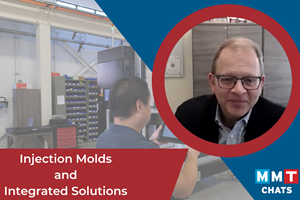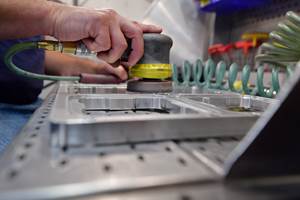Scholle IPN and Tooling 4.0
The MMT editorial team went onsite at Scholle IPN in Northlake, IL, and talked with Don Smith, senior tooling manager, to learn what Tooling 4.0 means to this company.
There is a lot of talk about Industry 4.0 these days, but MoldMaking Technology Editorial Director Christina Fuges wants to talk about Tooling 4.0. Recently, the MMT editorial team went onsite at Scholle IPN in Northlake, IL, and talked with Don Smith, senior tooling manager, to learn what Tooling 4.0 means to this company.
Watch the videos, and read the transcript below!
CF: Who is Scholle IPN?
DS: Scholle IPN is a global packaging company that manufactures flexible packaging materials for a variety of industries. You may not have heard of us, but we guarantee you’ve interacted with our products that are used around the world in dispensing everything from soda, smoothies, and coffee, to motor oil, and insecticides used in industrial farming. We engineer flexible packaging solutions that are safe, natural, economic, and sustainable for 22 different markets. Our products are made around the globe—not so we can produce cheaper elsewhere, but to effectively serve and produce right in the markets where we operate. Our molds use a variety of hot runner systems that are generally gated directly to the part, in high cavitation molds (16 cavities or higher).
CF: What is your role here?
DS: I am the Senior Tooling Manager for Scholle IPN Packaging NA, and as the company moves towards the future, and creates new products or re-tools its core products, we need to look at the most technically advanced tooling available. With that objective in mind, I’ve lead the team to set out on its Industry 4.0 journey to take its tooling to the next level.
CF: What do you mean by next level tooling or Tooling 4.0?
DS: I mean learning what is going on inside of the mold, during each cycle, by taking measurements of the physical dynamics … using scientific molding and data gathering. It means measuring pressure, temperature, and time, for example. So, instead of flying by the seat of our pants, we can now fly by instruments, and actually, understand what is happening inside of the mold and then make any necessary adjustments. For example:
- Meet cycle time requirements with new mold components by using additive manufacturing, better venting, or monitoring with pressure sensors to provide feedback through the mold, into the press, then onto the production environment.
- Test mold designs virtually with software, to get feedback and to set baselines for cycle time.
- Test a mold with software and sensors to see where the team needs to optimize for cooling, pressure, pack, balance, etc.
- Qualify a mold using a scientific method to create a Design of Experiments (DOE) to generate the process window, and to set sensors minimum/maximum levels.
- Use high-speed electric molding machines that feedback information via pressure and temperature sensors, and relay information back to the system, keeping the mold in control and achieving lights-out manufacturing.
CF: How does Scholle put this into practice?
DS: Here we reviewed our fleet of molds and chose a project based on historical downtime issues: two identical molds experiencing short shots and imbalance issues. The primary objective was to learn about the pressure dynamics that were occurring between the molding machine and the mold. We designed this project to run in two phases. During Phase 1 we ensured the hot runner system was not losing any heat due to long drops required by the mold design then determined that full heat containment is required on these molds before moving to Phase 2 when we installed RJG pressure sensors into the molds and molding machines, ran a DOE to set the high and low limits for the system to measure and re-programs the robotic removal system to determine whether to accept individual parts or to send an individual part to the scrap bin. Now that these 4.0 components are “talking” to one another, a non-filled part will then be placed DIRECTLY into the reject bin. This is Scholle IPN’s first continuous improvement project on injection molds using Industry 4.0 technology: Tooling 4.0.
CF: Explain the difference between a designed mold and an engineered mold?
DS: Engineering, by definition, is the application of mathematics, as well as scientific, economic, social, and practical knowledge to invent, innovate, design, build, maintain, research, and improve structures, machines, tools, systems, components, materials, processes, solutions, and organizations. Design is the intentional creation of a plan or specification for the construction of an object or system for the implementation of an activity or process.
Engineering a product (in this case, the injection mold) means to achieve measurable outputs via mathematics and science. Outputs include balancing runner systems (Beaumont theory), mold temperature control (calculate GPM; temperature sensors), conformal cooling (estimated cycle time and part quality targets) and calculations for optimized venting (pressure sensors). In the Industry 4.0 era, engineered molds with digital outputs will be the norm and the mold supplier committed to “engineered” molds is the mold builder of the future.
For more information, visit moldmakingtechnology.com, or read the complete Scholle IPN and Tooling 4.0 feature here.
Related Content
Hammonton Mold, ADOP France Forge Strategic Partnership in Injection Blow Moldmaking
Hammonton Mold Inc., a leading full-service mold shop based in New Jersey specializing in injection blow molds (IBM), proudly announces its official partnership with ADOP France, a prominent IBM mold manufacturer based in Normandy, France.
Read MoreMMT Chats: Injection Molds and Integrated Solutions Through Ambition and Innovation
Jordan Robertson, VP, Business Development and Marketing for StackTeck discusses various mold technologies to improve efficiencies in automation, cooling, lightweighting and sustainability.
Read MoreInnovative Mold Building Enhances Packaging Material Efficiency, Elevates Recyclable Design
A manufacturing-focused design and optimized tooling enhance material efficiency in packaging for a new medical instrument.
Read MoreMMT Chats: Digitalizing Mold Lifecycle and Process Performance
MMT catches up with Editorial Advisory Board member Bob VanCoillie senior manager of Kenvue’s mold management center of excellence outside of Philadelphia to discuss mold management via tooling digitalization and OEM expectations and opportunities.
Read MoreRead Next
How to Use Strategic Planning Tools, Data to Manage the Human Side of Business
Q&A with Marion Wells, MMT EAB member and founder of Human Asset Management.
Read MoreReasons to Use Fiber Lasers for Mold Cleaning
Fiber lasers offer a simplicity, speed, control and portability, minimizing mold cleaning risks.
Read MoreHow to Use Continuing Education to Remain Competitive in Moldmaking
Continued training helps moldmakers make tooling decisions and properly use the latest cutting tool to efficiently machine high-quality molds.
Read More





















